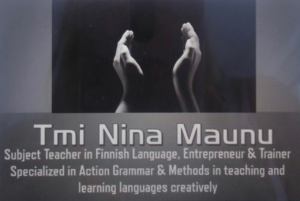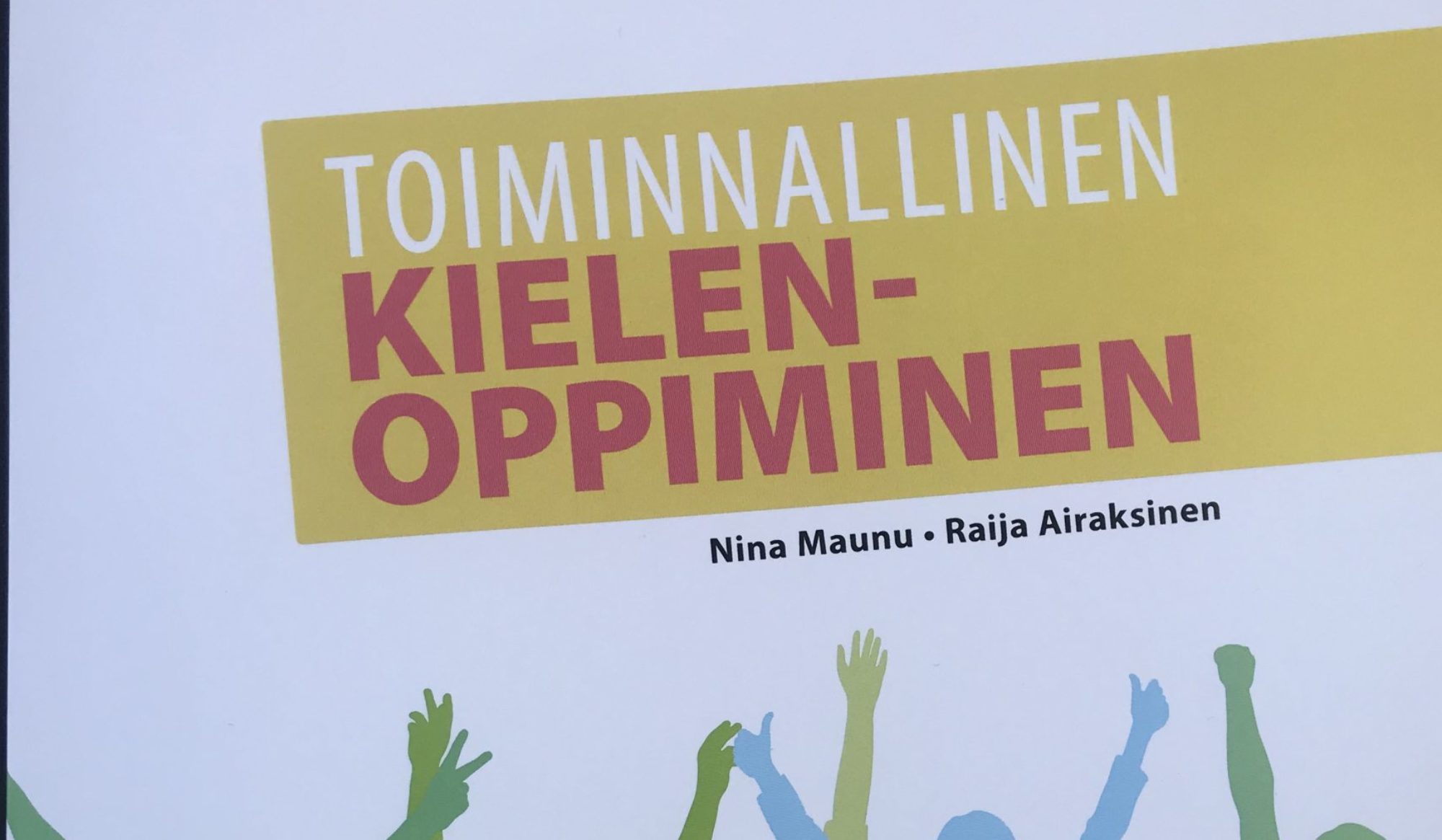Nina Maunu

Nina Maunu, Master of Arts, Finnish language teacher and trainer of action grammar and action methods in (language) learning
Active teacher trainer since the year 2011
E.g., year 2019: 26 training days all over in Finland to teachers and to teacher educators to all levels from primary schools to universities
Board of Education, universities, the local branches of languages, cities, municipalities, and schools as subscribers
Founder of the Facebook group Toiminnallinen kielen oppiminen [Active based language learning], over 11 900 members (27.1.2023)
Homepage: www.ninamaunu.com, Old Blog Ninan jutinoita: http://ninamaunu.blogspot.fi (see some pictures there!)
I’ve developed and tested many kinds of methods to ease learning languages with my students, colleagues, and e.g. with dancers at Zodiak – Center for New Dance in Helsinki and in many other locations in Finland actively since 2008. My methods are based on movement, drama, improvisation, storytelling, visualizations, kinesthetic games, and activities and are designed to ease learning languages whether foreign or mother tongues. My methods are applicable to learners of any age, levels, and skills.
I’ve got always superior results and feedback from teachers and students. Also, University of Turku has done research about teaching Action grammar during the years 2008-2011 with convinced results. I’ve been participated to that research by using action methods in my classrooms in those years and still.
Contact information
Video about the book Action language learning (2020)
2) Video (8 minutes) about me, the book Toiminnallinen kielenoppiminen (Otava, 2020), Erasmus group Playing beyond CLIL (2019-2021), theatre and training group Interacting and from where all began about 10 years ago: the activity called Busy Bee, Surinasiivet.
Click here to see 8 minutes video:
https://drive.google.com/file/d/1MValcqzoh9NSaFn08tcP00QmDZhmsGom/view?usp=sharing
PRESENTATIONS
- My presentation Movement and improvisation in language learning at IDEA (International Drama and Theatre Education Association) conference in Reykjavik Iceland 7.7.2022. You can find some slides of the presentation from here:
https://docs.google.com/presentation/d/1i6Mhb2m-eKCLFkAdvSqg0mLkU9UIEju_wcC8bUrfbVE/edit?usp=sharing
From the slides you can read more about me, my trainings, why I´m doing this and feedback, theoretical background, supportive groups, sources, Finnish curriculum which support this kind of action learning.
2. The idea of presentation of characterizing grammar terms:
The new Finnish National Curriculum (2016) emphasizes both movement and drama in action-based learning, which has increasingly gained popularity in Finland. The learner, considered as an active individual, is encouraged to express his/her knowledge, learning and emotions through a variety of physical activities and creative ways. This presentation introduces ways of making grammar and terms related to it motivating to the learner by embodying grammar as characters and playing with them. Movements, improvisation, and drama activities motivate learners and help them to better understand and remember grammar.
Introducing diverse ways of making grammar characters:
1. Connections to Commedia dell´arte
2. Visualizations from drawings to body language
3. Asking learners step-by-step how they would make a grammar character:
What kind of personality the character is and why?
What does it/ she/ he want/ need/ fear/ admire?
Does the character have relatives and hobbies? etc.
4. Options for using associations in embodying grammar terms to strengthen characters:
a) imagining different shoes to every character
b) a term as an animal character
c) a term as a letter character (type)
5. Playing with characters:
a) forming pairs, groups, families etc.
b) choosing an activity to the character´s speech practise: statues, hot seat, improvisation etc.
c) telling stories and/ or improvising the characters´ lives as a scene, play or process drama
1. small groups, 2. everybody together
(This presentation was accepted to Singapore Drama Conference in the summer 2023, but I couldn´t make it.)
3. AN EXAMPLE TEACHER TRAINING CONTENT HOW TO USE MOVEMENT IN A CLASSROOM (in all levels of schools, lesson, and workshop)
GENERAL
- Why move during lessons?
- Several ways of moving
- Involving the learner in planning the process
ACTION-LEARNING FOR ALL LESSONS
- Movement and meaning
- Interaction with movement: what is to be learned and tuning in
- Movement and emotions
- Situated movement
- Movement as group work
- Using movement to assess learning, self-assessment, assessment as groups
- Sample structure an action-based learning session 7.1 What is to be learned: focus on the topic/subject content 7.2 How will it happen: communality, self-knowledge, team spirit 7.3 Action: Learning by moving with the subject content 7.4 Moving with visualization 7.5 Designing movements together with the teacher and the learners; Action routes group works 7.6 What has been learned: recall and combine 7.7 Closing, feedback and thanking
| Nina Maunu, Subject teacher in Finnish language, drama teacher in a compulsory-secondary comprehensive school, entrepreneur and trainer specialized in teaching and learning languages creatively. Writer of the book and founder of the Facebook group (11 900 members) Toiminnallinen kielenoppiminen (Active language learning). Has given presentations in European Universities. |
